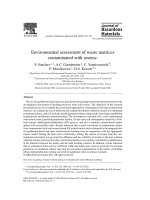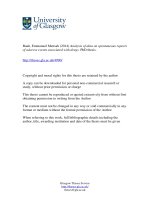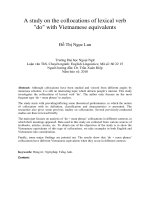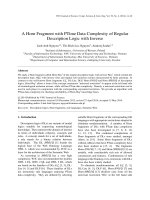Bioremediation of industrial wastewaters contaminated with hazardous compound
Bạn đang xem bản rút gọn của tài liệu. Xem và tải ngay bản đầy đủ của tài liệu tại đây (143.33 KB, 3 trang )
Seediscussions,stats,andauthorprofilesforthispublicationat: />
BioremediationofIndustrialWastewaters
ContaminatedWithHazardousCompound
Data·August2015
CITATIONS
READS
0
56
2authors:
VickyDritsa
FotisRigas
NationalTechnicalUniversityofAthens
NationalTechnicalUniversityofAthens
28PUBLICATIONS263CITATIONS
143PUBLICATIONS1,152CITATIONS
SEEPROFILE
SEEPROFILE
AllcontentfollowingthispagewasuploadedbyFotisRigason26August2015.
Theuserhasrequestedenhancementofthedownloadedfile.
In: Bioremediation: …
Editors: Alexander C. Mason
ISBN: 978-1-61122-730-7
©2010 Nova Science Publishers, Inc.
Chapter 10
BIOREMEDIATION OF INDUSTRIAL WASTEWATERS
CONTAMINATED WITH HAZARDOUS COMPOUNDS
Vicky Dritsa and Fotis Rigas
National Technical University of Athens,
School of Chemical Engineering, Athens, Greece
ABSTRACT
Intensive industrialization generates by-products or residues, which are usually
hazardous (toxic and/or persistent) to the environment and to humans. The most
hazardous pollutants include heavy metals, polyaromatic hydrocarbons (PAHs),
polychlorinated biphenyls (PCBs), pesticides and synthetic dyes. For more than a century
industrialized countries contaminate systematically soil, water and air with such
materials. Yet, it was only after the 1980s that remedial actions were undertaken and the
laisser-faire approach was set aside. With regard to soil and water contamination, the
general term “site remediation” is usually used. This term is not limited to the cleaning of
contaminants in either a solid matrix (mainly soil) or in liquid media (groundwater or
surface water), because in some cases there is no clean-up at all, and in fact the
contaminants are contained or immobilized in place. Therefore, the term “remediation”
should be seen as having broader meaning than “cleanup”.
Biological treatment technologies have played an important role in the degradation
of hazardous environmental pollutants. Bioremediation is a diverse clean-up technology,
cost-effective and environmentally friendly compared to the traditional commonly used
physico-chemical techniques. The term “soft technology” is sometimes used for
biotechnology to distinguish from the most drastic and environmentally affecting
physico-chemical techniques. Bioremediation involves the use of various microbial
organisms for eliminating environmental pollutants. It may be a permanent solution and
may even lead to complete mineralization of organic pollutants, leaving the ecosystem
intact. The most important factors for the success of this technology are the availability of
suitable microbes in the contaminated medium, the type and concentration of pollutants
and the environmental conditions.
This chapter reviews the recent bioremediation research on a range of pollutants in
wastewaters produced by industries such as alcohol distilleries, olive mills, and paper and
pulp mills industries. Treatment and reuse of effluents present significant challenges due
to the characteristics of the wastewater such as high chemical oxygen demand (COD),
high content of persistent pollutants and dark colour. Many species have been isolated
and characterized as pollutant-degrading microorganisms. Biodegradation and
biosorption have been extensively studied using pure or mixed cultures of fungi and
bacteria. The evaluation of the proper microorganism(s) is normally the first step for a
biological treatment of pollutants. An extended review of the microorganisms,
emphasized on bacteria and fungi that have been tested for the removal of the specific
pollutants in the industrial wastewater is given in this chapter.
View publication stats









